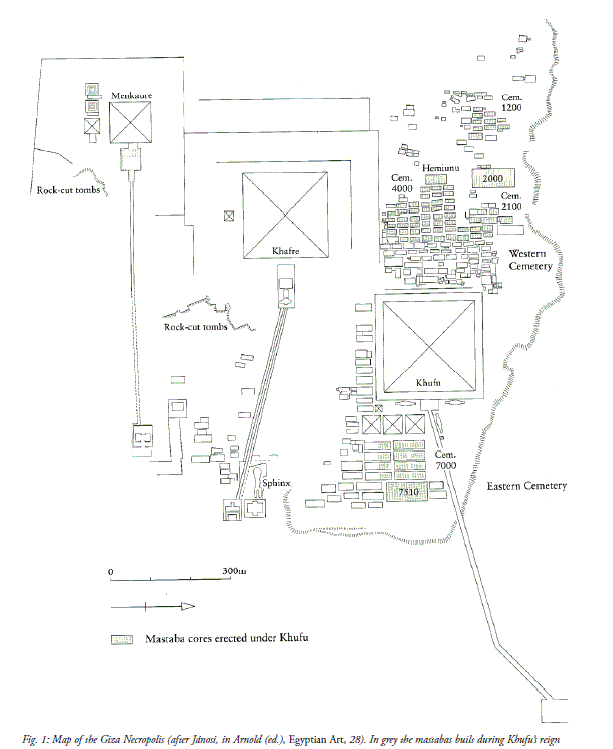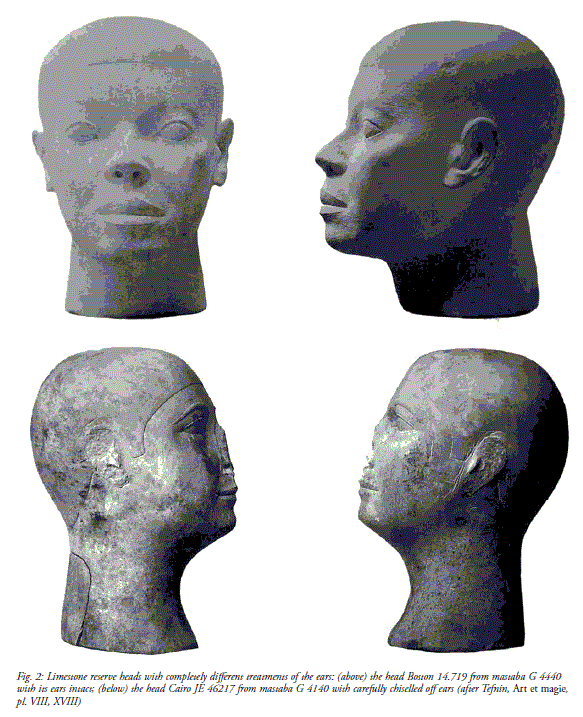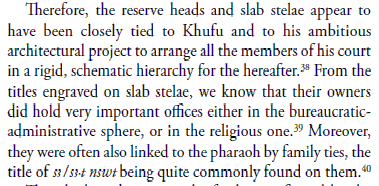It looks like you're using an Ad Blocker.
Please white-list or disable AboveTopSecret.com in your ad-blocking tool.
Thank you.
Some features of ATS will be disabled while you continue to use an ad-blocker.
12
share:
What are 'reserved heads'?
Excavations in the west field the area of mastaba tombs next to Khufu horizon found a number of representations of heads. Images of some of these are shown below. At this time not consensus has been arrived at to what they meant or why the AE put them into these tombs.
These heads were found in the well known Giza necropolis

A detail image of the specific locations the heads were found - clearer images are in the PDF link below

The heads, a total of 31 were found in this cemetery and few in other locations. The last was found



What were these heads for? That is unknown the AE don't mention them in the limited texts that have come down to us....so there are lots of theories, one is noted below

..for the rest of the information you'll have to read the PDF
Link to Massimiliano Nuzzolo PDF on this subject
Excavations in the west field the area of mastaba tombs next to Khufu horizon found a number of representations of heads. Images of some of these are shown below. At this time not consensus has been arrived at to what they meant or why the AE put them into these tombs.
These heads were found in the well known Giza necropolis

A detail image of the specific locations the heads were found - clearer images are in the PDF link below

The heads, a total of 31 were found in this cemetery and few in other locations. The last was found
The last head found at Giza comes from the Central Field, more specifically from the so-called ‘Tomb of Khafre’s Daughter’ dated in a period spanning the reigns of Khufu and Khafre.



What were these heads for? That is unknown the AE don't mention them in the limited texts that have come down to us....so there are lots of theories, one is noted below

..for the rest of the information you'll have to read the PDF
Link to Massimiliano Nuzzolo PDF on this subject
Cool find, never knew about this.
Here is some more info:
The Wiki page is a pretty good read for more info.
Wiki
Here is some more info:
Reserve heads (also known as "Magical heads" or "Replacement heads", the latter term derived from the original German term "Ersatzköpfe") are distinctive sculptures made primarily of fine limestone that have been found in a number of non-royal tombs of the Fourth dynasty of Egypt; primarily from the reigns of pyramid-building pharaohs Khufu to Khafre, circa 2551-2496 B.C.[1] While each of the heads share characteristics in common with each other (and some examples may be more caricature than reflecting a true-life appearance), the striking individuality of the pieces makes them some of the earliest examples of portrait sculpture in existence.
Their purpose is not entirely clear; the name comes from the prevalent theory first put forward, in 1903, by the German Egyptologist Ludwig Borchardt that the head was to serve as an alternate home for the spirit of the dead owner should anything happen to its body.[1]
The Wiki page is a pretty good read for more info.
Wiki
reply to post by Julie Washington
Thanks Julie I was just going to put more material into my original post and you beat me to it, thanks
Its an interesting puzzle
Thanks Julie I was just going to put more material into my original post and you beat me to it, thanks
Its an interesting puzzle
The name - Reserved Heads - made me think that they were ready made sculpted heads that the Egyptians that did the sculpting had ready made models to
sculpt quickly when a person who was worthy of a sculpted head, could be quickly completed as they were mummified.
The heads pictured look unfinished to me and that is what I based my quick hypothesis from.
The heads pictured look unfinished to me and that is what I based my quick hypothesis from.
new topics
-
Glass of Time…Time2024 writer
Short Stories: 11 minutes ago -
Democrats Introduce Bill That Will Take Away Donald Trumps Secret Service Protection
2024 Elections: 28 minutes ago -
Planned Parenthood Targets Black Neighborhoods
Social Issues and Civil Unrest: 1 hours ago -
Who could it beeee now?
New World Order: 4 hours ago -
The Russian Vostok complex has been put into operation in Antarctica
Science & Technology: 5 hours ago -
Letitia James tells judge to Reject Trumps $175 Million Bond
2024 Elections: 5 hours ago -
Tucker Carlson UFOs are piloted by spiritual entities with bases under the ocean and the ground
Aliens and UFOs: 5 hours ago -
Hello from burritocat
Introductions: 7 hours ago -
An Apology From the Dunderbeck Sausage Company
Music: 9 hours ago -
Tucker on Joe Rogan talking Kona Blue and UFOs
Aliens and UFOs: 10 hours ago
top topics
-
The Russian Vostok complex has been put into operation in Antarctica
Science & Technology: 5 hours ago, 11 flags -
Michigan school district cancels lesson on gender identity and pronouns after backlash
Education and Media: 14 hours ago, 11 flags -
WF Killer Patents & Secret Science Vol. 1 | Free Energy & Anti-Gravity Cover-Ups
General Conspiracies: 12 hours ago, 8 flags -
Remember These Attacks When President Trump 2.0 Retribution-Justice Commences.
2024 Elections: 10 hours ago, 8 flags -
Letitia James tells judge to Reject Trumps $175 Million Bond
2024 Elections: 5 hours ago, 7 flags -
Pentagon acknowledges secret UFO project, the Kona Blue program | Vargas Reports
Aliens and UFOs: 17 hours ago, 7 flags -
Boston Dynamics say Farewell to Atlas
Science & Technology: 17 hours ago, 6 flags -
Israel attacking Iran again.
Middle East Issues: 14 hours ago, 5 flags -
Who could it beeee now?
New World Order: 4 hours ago, 5 flags -
Hurt my hip; should I go see a Doctor
General Chit Chat: 13 hours ago, 3 flags
12
